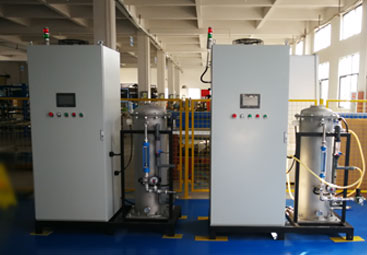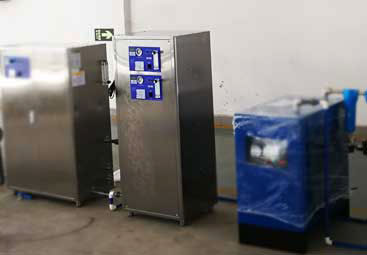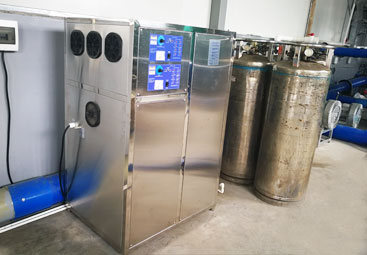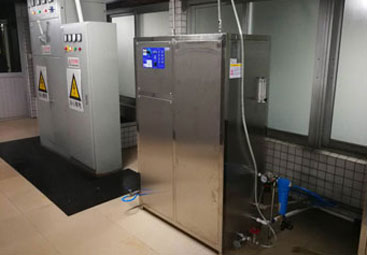Glossary of terms related to ozone
Author:www.dahuan.net Views:date:2019-01-14 09:56
Ozone production: is the yield of ozone, the amount of ozone produced in hours. Unit of measurement: mg/h, g/h, kg/h. Concentration × flow rate
Ozone concentration: The amount of ozone per unit volume. Unit of measurement: mg/L, mg/m3, ppm
Water soluble ozone concentration: Ozone is dissolved in water, the ozone content per unit volume. Unit of measurement: mg/L, ppm
Ozone concentration for air application: The concentration of ozone used for air disinfection is generally 1-10 mg/m3.
Environmental ozone concentration: The concentration of ozone contained in the ambient air, the environmental quality standards specified in the environmental quality standards are 0.12/0.16/0.2 mg/m3.
Power consumption: The power consumption of the ozone generator unit for every 1kg of ozone generated without the air handling system. (This unit is an indicator for evaluating the performance of the ozone generator, which is different from the power of the equipment). Unit of measurement: kwh/kgO3
Addition amount: The amount of ozone added to a certain unit of liquid or gas. Unit of measurement: g/m3, g/T
Production of unit discharge area: The amount of ozone generated per unit area of the discharge medium, which is an indicator for evaluating the performance of the discharge medium. Unit of measurement: g/m3
Dew point: is an indicator of air dryness. At what temperature the air begins to dew condensation. Unit of measurement: °C.
Inlet Air Flow: The amount of material gas entering the ozone generator discharge chamber per hour. Unit of measurement: m3 / h
Exhaust flow: The flow rate of ozonated mixed gas per hour from the generator discharge chamber. Unit of measurement: m3 / h
Intake pressure: The pressure of the material gas entering the discharge chamber of the ozone generator. Unit of measurement: MPa
Photochemical generation of ozone: A method of decomposing and polymerizing oxygen molecules by ultraviolet light to form ozone.
Chemical Ozone Production: A method of electrolyzing an oxygen-containing electrolyte to produce ozone using a DC power source.
Corona discharge method: A method in which an alternating oxygen high-voltage electric field is used to generate a corona discharge of an oxygen-containing gas, and a high-energy free electron in a corona dissociates an oxygen molecule and polymerizes to form an ozone molecule.
Air gap discharge method: A type of corona discharge in which a discharge region occurs in a region between a dielectric layer and a high voltage electrode or a low voltage electrode.
Fringe discharge method: A type of corona discharge in which a discharge region occurs at the edge of a high voltage electrode.
DTA Discharge Body: An enamel is the main dielectric ozone discharge body with high output and high concentration.
Electrode: A conductive portion that forms a conductive interface with a medium having a different electrical conductivity, and an electric conductor that distributes a high voltage electric field in the ozone generating unit.
Medium tube (plate): The basic electromagnetic field performance is a component composed of a substance polarized by an electric field. In the ozone generating unit, it is located between the two poles, resulting in a stable glow. Light discharge insulator.
Dielectric Barrier Discharge: A gas discharge phenomenon caused by an alternating voltage applied and raised in an electrode and a discharge space blocked by a dielectric.
Medium strength: The highest electric field strength that a dielectric material can withstand without being damaged.
Ozone generating unit: constitutes the most basic component for generating ozone, such as an ozone generating unit that discharges with a corona air gap as a high voltage electrode, a ground electrode, a medium, and an air gap.
Ozone generating unit: The basic component for generating ozone, consisting of a dielectric body and an electrode and a discharge space separated by it.
Ozone generation room: A device consisting of one or more groups of ozone generating units
Ozone generator: A device necessary for the production of ozone by oxygen or air through a dielectric barrier discharge.
Ozone system: Part or all of the equipment combination of ozone generator, gas source device and contact reaction device.
Standard state: The gas state at a temperature T = 273.15 K (0 ° C) and a pressure P = 101.325 kPa (standard atmospheric pressure).
Ozone:O3, composed of three oxygen atoms, is a trace component of the natural atmosphere, with an average content of 0.1-0.01 ppm, most concentrated in the stratosphere of 10~30km, tropospheric ozone Only 10%. If at zero degrees Celsius, the ozone in the atmosphere is compressed to an atmospheric pressure in the vertical direction, the thickness is only about 3 mm, which is equivalent to the thickness of two 5 cent coins stacked together. The chemistry of ozone in the Earth's atmosphere plays a very important role in maintaining the Earth's energy balance and ecological balance by absorbing solar radiation.
Ozone Layer:Ozone Layer, the atmosphere that concentrates most of the ozone in the atmosphere in the stratosphere.
Ozone depletion: Ozone Depletion, the ozone concentration in the ozone layer is in a dynamic equilibrium, maintaining a certain concentration, and the ozone concentration in the ozone layer is reduced due to other reasons, called the ozone layer loss.
Antarctic Ozone Hole:Ozone Hole, observed in the 1980s, since the end of September each year, the total amount of ozone over Antarctica has been rapidly reduced by about half, in the center of the ozone layer over the polar region, nearly 90% of ozone It is destroyed. If it is observed from the ground up, the high-altitude ozone layer is extremely thin. Compared with the surrounding, it forms a hole with a diameter of thousands of kilometers, called the “ozone hole”.
D.U.: Dobson Unit, defined as 0°C, under standard sea level pressure, 10-5m thick ozone as 1 Dobson. The Dobson spectrophotometer used to measure Dobson units was used by the World Meteorological Organization as a standard measuring instrument. "Total ozone" refers to the total thickness of the ozone column, and describes the integrated height of the column density, expressed in centimeters (STP).
TOMS:Total Ozone Mapping Spectrometer, an instrument equipped to measure global ozone concentrations on satellites
ODS:Ozone Depletion Substances, ozone depleting substances
ODP:Ozone Depletion Potential, the potential ability to characterize a substance causing ozone depletion. ODP is defined as the loss of O3 caused by a unit mass species divided by the O3 loss caused by the unit mass of CFC-11.
GWP:Global Warming Potential, Global Warming Potential
CFC:(Chlorofluorocarbon), chlorofluorocarbons
UV-B:Ultraviolet-B, refers to ultraviolet light with a wavelength between 290 and 320 nm
UV-C: refers to ultraviolet light with a wavelength between 320 and 400 nm.
UV-A: refers to ultraviolet light with a wavelength of less than 290 nm
SOD:Stratospheric Ozone Depletion, Stratospheric Ozone Depletion
Freon:Freon, trade name for chlorofluorocarbons
Halons:Halon, containing bromide
Flocculation: In the chemical field, the colloid is suspended in the form of flocs or flakes. This effect differs from the precipitation in that the colloid is only suspended in the liquid and is practically insoluble in the solution prior to flocculation. In the flocculation system, no filter cake is formed because all flocs are in suspension
Antimicrobial: A substance that kills or inhibits the growth of microorganisms [1], such as bacteria, fungi or protozoa. Antibacterial drugs can kill microorganisms (microorganisms) or prevent microbial growth (microbial inhibition). Disinfectants are antibacterial substances used in non-biological organisms.
Corona Discharge: This is the most popular type of ozone generator for most industrial and personal uses. Although there are variations in the "hot spark" corona discharge method for ozone production, including medical grade and industrial grade ozone generators, these units typically operate through corona discharge tubes. [42] They are usually very cost effective and do not require an oxygen source other than ambient air. However, they also produce nitrogen oxides as a by-product. The use of an air dryer can reduce or eliminate the formation of nitric acid by removing water vapor and increasing ozone production. The use of an oxygen concentrator can further increase ozone production and further reduce the risk of nitrate formation by not only removing water vapor but also removing most of the nitrogen.
UV Light: Ultraviolet Ozone Generator or Vacuum Ultraviolet (VUV) Ozone generator uses a source of narrow-band UV light, which is part of the sun. The sun's ultraviolet rays maintain the ozone layer of the Earth's stratosphere. Although standard UV ozone generators tend to be less expensive, [need to clarify] they typically produce ozone at a concentration of about 0.5% or less. Another disadvantage of this method is that it requires exposure of air (oxygen) to the UV source for a longer period of time and does not treat any gases that are not exposed to the UV source. This makes it impractical for the UV generator to be used in the case of handling fast moving air or water streams (eg, air disinfection in a pipeline). Ozone production is one of the potential dangers of UV germicidal radiation. VUV ozone generators are used in swimming pool and spa applications and range from millions of gallons of water. Unlike corona discharge generators, VUV ozone generators do not produce harmful nitrogen by-products, and unlike corona discharge systems, VUV ozone generators work very well in humid air environments. There is also generally no need for expensive exhaust mechanisms or air dryers or oxygen concentrators that require additional cost and maintenance.
Cold Plasma: In the cold plasma method, pure oxygen is exposed to a plasma generated by a dielectric barrier discharge. The diatomic oxygen is split into individual atoms and then recombined in the triplet state to form ozone. The cold plasma machine uses pure oxygen as the input source to produce a maximum concentration of about 5% ozone. They produce more ozone in a given time than UV generation. However, since cold plasma ozone generators are very expensive, they are found to be less than the first two types. The discharge appears as a filamentous transfer of electrons (microdischarge) in the gap between the two electrodes. In order to evenly distribute the microdischarge, a dielectric insulator must be used to separate the metal electrodes and prevent arcing. Some cold plasma units also have the ability to produce short-lived oxygen allotropes, including O4, O5, O6, O7, and the like.
-- End --
Next Page :The application of ozone in the car wash industry Previous Page:Swimming pool ozone generator sterilization principle
We found other products you might like!
Similar article ranking
- Glossary of terms related to ozone
- Application of ozone in cold storage
- Can ozone generator remove formaldehyde
- Swimming pool water disinfection ozone application technolog
- The application of ozone in the car wash industry
- space disinfection equipment selecting
- Application of ozone generator in sewage treatment
- How long after ozone disinfection will the air return to a s
- Ozone generator solution for disinfecting pure water and min
- Application of ozone in washing water industry
Ozone Equipment
- 50g-100g Ozone Generator
- Portable Household Ozone Generator
- 40g-100g ozone & oxygen machine
- SOZ-10G ozone generator
- 40g-200g ozone & oxygen machine
- OW Series Oxygen Generator
- DH-A Dryer
- Negative Pressure Ozone Generator
Ozone Application
- Residential Air purification Application
- ozone Application in wastewater treatment
- Ozone application in aquarium
- Ozone Application in Aquaculture
- ozone Application in Pure water treatment
- Ozone application in swimming pools
Latest news articles
- Ozone generator components and functions
- Ozone generator air source comparison
- Application of ozone generator in sewage treatment
- Application of ozone in cold storage
- How to ensure that ozone concentrations in clean areas are u
- How long after ozone disinfection will the air return to a s
- Application of ozone in washing water industry
- Can ozone generator remove formaldehyde
- How to ozone disinfection of bottled water
- Ozone generator solution for disinfecting pure water and min
- Swimming pool water disinfection ozone application technolog
- The application of ozone in the car wash industry
- Glossary of terms related to ozone
- Swimming pool ozone generator sterilization principle
- space disinfection equipment selecting
- Precautions for selecting a space disinfection ozone generat
- Method for preparing ozone during swimming pool disinfection
- Warmly celebrate the 21st anniversary of BNP
- Ozone generator concentration constant constant system
- Textile and garment fabric ozone decolorization system




